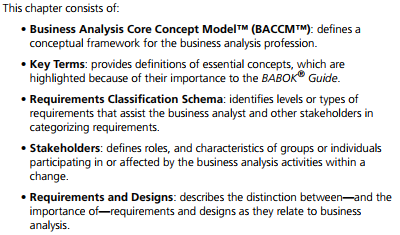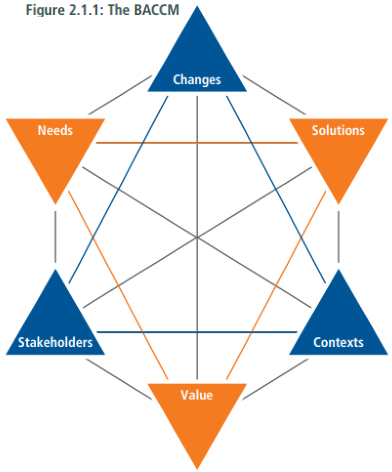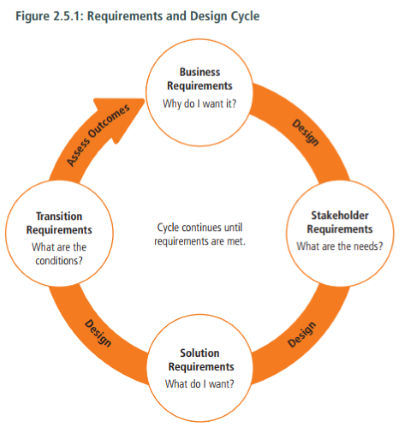Business Analysis Key Concepts
Chapter 2. Business Analysis Key Concepts

1. The Business Analysis Core Concept Model (BACCM)
- Change: The act of transfomation in response to a need.
- Need: A problem or opportunity to be addressed.
- Solution: A specify way of satisfying one or more needs in a context.
- Stakeholder: A group or an individual with a relationship to the change, the need, or the solution.
- Value: The worth, importance, or usefulness of something to a stakeholder within a context.
- Context: The circumstances that influence, are influenced by, and provide understanding of the change.

2. Key Terms
- Business Analysis: The BABOK Guide describles and defines business analysis as the practice of enabling change in a enterprise by defining needs and recommend solutions diliver value to stakeholders.
- Business Analysis Information: BAI refers to the broad and diverse sets of information that business analysists analyze, transform, and report.
- Design: A design is a usable prepresentation of a solution.
- Enterprise: An enterprise is a system of one or more organizations and the solutions they use to pursue a shared set of common goals.
- Organization: An autonomous group of people under the management of a single individual or board, that works towards common goals and objectives.
- Plan: A plan is a proposal for doing or achieving something.
- Requirement: A requirement is a usable representation of a need.
- Risk: Risk is a effect of uncertainty on the value of a change, a solution, or the enterprise.
3. Requirement Classification Schema
- Business Requirements: statements of goals, objectives, and outcomes that describe why a change has been initiated.
- Stakeholder Requirements: describe the needs of stakeholder that must be met in order to achieve the business requirements.
- Solution Requirements: describe the capabilities and qualities of a solution that meets the stakeholder requirements.
+ functional requirements: describe the capabilities that a solution must have in terms of the behaviour and information that the solution will manage, and
+ non-functional requirements or quality of service requirements: do not relate directly to the behaviour of functionality of the solution, but rather describe conditions under which a solution must remain effective or qualities that a solution must have.
- Transition Requirements: describe the capabilities that the solution must have and conditions the solution must meet to facilitate transition from the current state to the future state, but which are not needed once the change is complete.
4. Stakeholders
- Business Analysist: The business Analysist is inherently a stakeholder in all business analysis activities.
- Customer: A customer users or may use product or services produced by the enterprise and may have contractual or moral rights that enterprise is obliged to meet.
- Domain Subject Matter Expert: A domain subject matter expert is any individual with in-depth knowledge of a topic relevant to the business need or solution scope.
- End User: End users are stakeholders who directly interact with the solution.
- Implementation Subject Matter Expert: An implementation subject matter expert is any stackeholder who has specialized knowlegde regarding the implementation of one or more solution components.
- Operational Support: Operational support is responsible for the day-to-day management or maintenance of a system or product.
- Project Manager: Project managers are responsible for managing to work required to deliver a solution that meets a business need, and for ensuring that the project's objectives are met while balancing the project factors including scope, budget, schedule, resources, quality, and risk.
- Regulator: Regulators are responsible for the definition and enforcement of standards.
- Supplier: A supplier is a stakeholder outside the boundary of a given organization of organization unit.
- Tester: Tester are responsible for determining how to verify that the solution meets the requirements defined by the business analysist, as well as conducting the verification process.
5. Requirements and Designs
Eliciting, analyzing, validating, and managing requirements have consistently been recognized as key activities of business analysis. However, it is very important to recognize that business analyst are also reponsible for the difinition of design, at some level, in an initiative. The level of responsibility for design varies based on the perspective within which a business analysist is working.
| Requirement | Design |
| View six months sales data across multiple organizational units in a single view | A sketch of a dashboard |
| Reduce amount of time required to pick and pack a customer order. | Process model |
| Record and access a medical patient's history | Screen mock-up showing specific data field |
| Develop business strategy, goals, and objectives for a new business | Business Capability Model |
| Provide information in English and French | Prototype with text displayed in English and French |
